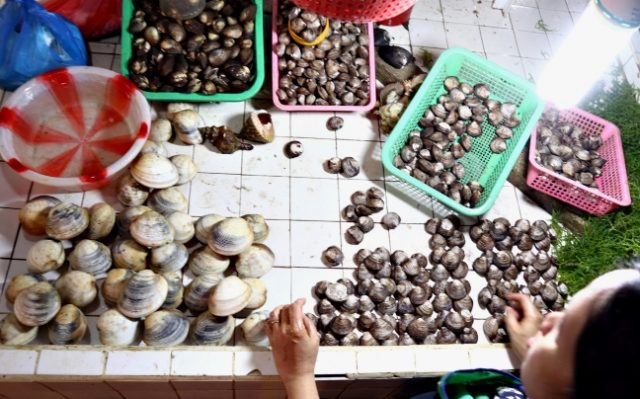Butuan City – The Bureau of Fisheries and Aquatic Resources (BFAR) has hoisted a warning and ban on the harvest and consumption of shellfish coming from Lianga Bay in Surigao del Sur, after discovery of a toxic red tide phenomenon there.
So-called Red Tide results from marine nutrient levels of nearshore water that reach sufficient levels to trigger a bloom of reddish dinoflagellates that harbor toxins, which get lodged in marine animals and seafood like bi-valve seashells and crustaceans, and therefore get passed up the food chain. The water become tinged with the reddish algae, thus earning the monicker red tide.
“We have disseminated throughout the municipal channels, as well as through local radio stations, the warning addressed to fisher communities to not take risks and temporarily desist from harvesting, marketing, buying and eating crabs, prawns and shellfish from the towns of Lianga and Barobo here in Surigao del Sur,” said Benesita P. Rojas, acting Provincial Fisheries and Aquatic Resource Officer of the province of Surigao del Sur.

Rojas acknowledged that the warning came December 8, 2017 from the BFAR national office, after tests were performed on local samples submitted for analysis.
The causative organism has not yet been disclosed in the current red tide episode, but according to BFAR Caraga, in previous years Pyrodinium bahamense and the variety compressum have been implicated in the outbreaks.
“Under Shellfish Bulletin No. 41 series of 2017, Lianga Bay in Surigao del Sur was found positive for the significant presence of red tide toxin based on the latest laboratory tests of BFAR. The red tide warning pointed out that all types of shellfish and Acetes specie, or commonly known as alamang, gathered from the area are not safe for human consumption,” said Rojas.
She added that, “as of the moment the towns of Lianga and Barobo are those placed on the warning, but I want to point out that other towns in the vicinity have also been advised.
“The waters of Lianga Bay cover several towns, we are also advising the local residents in the towns of San Agustin and Marihatag not to eat and consume any shellfish coming from Lianga Bay.
Proper handling
“While the adjacent waters of Hinatuan Bay and Bislig Bay had been found negative for the toxins, we would still urge them to make proper queries whether the shellfish was not caught within the coastal waters of Lianga Bay.”
“Let me make it clear that even if fish, squid, shrimps and crabs are safe for eating as long as they are properly and sufficiently cooked, they should be obtained fresh and washed thoroughly and the internal organs, such as gills and intestines should be properly removed, before cooking. I would also advice everyone not to eat anything raw while the warning is still in effect,” added Rojas.
Ivy S. Doguiles, operator of Erve’s Seafood Fastfood in Lianga, expressed her concern as the red tide warning would affect not only the daily consumption of the town but also the recovering tourism industry.
“After the warning was issued, our local fishermen, market vendors and establishments, such as our eatery businesses, stopped serving shellfish. We explained to visitors from faraway places the prevailing red tide situation. Unfortunately, this will effect our livelihoods, especially those who rely on their daily catch of shellfish for a living.
“We are slowly recovering from the negative effects of the Marawi crisis; right after the martial law declaration last May, tourist arrivals had trickled down, thus also affecting tours stopping over for meals,” said Doguiles.
Doguiles added that the situation is being complicated by the passage of Storm Urduja, which is preventing the fishermen from venturing out to harvest alternative marine species other than shell fish.
Water Pollution
According to a report by Water Environment Partnership in Asia or WEPA, the rapid increase in population, urbanization and industrialization count as factors that reduce the quality of Philippine waters.
The discharge of domestic and industrial wastewater and agriculture runoff has caused extensive pollution of the coastal water bodies. The effluent is in the form or raw sewage, detergents, fertilizers, heavy metals, chemical products, oil and solid waste.
The report stated that, “the extent of water pollution in the Philippines Bays can be gleaned from the frequent occurrence of red tide since it first came to the attention in 1983.
“Red tide usually occurs when high organic loading from rivers drain into bays resulting in harmful algal blooms (HABs). Records from 1983 to 2001, a total of 42 toxic outbreaks have resulted in a total of 2,107 paralytic shellfish poisoning cases with 117 deaths.”










